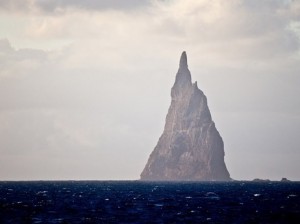 Ball’s Pyramid in the Tasman sea is located 19 kilometers from Lord Howe Island east of Australia.
Ball’s Pyramid in the Tasman sea is located 19 kilometers from Lord Howe Island east of Australia.March 1, 2012
Two Australian scientists, David Priddel and Nicholas Carlile have rediscovered Dryococelus australis, a giant walking stick, found on “Ball’s Pyramid.” It was thought to have died out.
It’s a stick insect, a critter that masquerades as a piece of wood, and the Lord Howe Island version was so large — as big as a human hand — that the Europeans labeled it a “tree lobster” because of its size and hard, lobsterlike exoskeleton. It was 12 centimeters long and the heaviest flightless stick insect in the world. Local fishermen used to put them on fishing hooks and use them as bait.
Its supposed extinction and then rediscovery is quite a story.
One day in 1918, a supply ship, the S.S. Makambo from Britain, ran aground at Lord Howe Island and had to be evacuated. One passenger drowned. The rest were put ashore. It took nine days to repair the Makambo, and during that time, some black rats managed to get from the ship to the island, where they instantly discovered a delicious new rat food: giant stick insects. Two years later, the rats were everywhere and the tree lobsters were gone.
Totally gone. After 1920, there wasn’t a single sighting. By 1960, the Lord Howe stick insect, Dryococelus australis, was presumed extinct.
 Ball’s Pyramid in the Tasman sea is located 19 kilometers from Lord Howe Island east of Australia.
Ball’s Pyramid in the Tasman sea is located 19 kilometers from Lord Howe Island east of Australia.
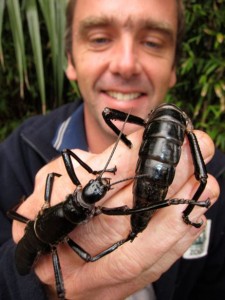
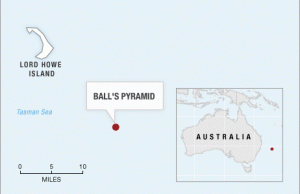
Fast forward to 2001, when two Australian scientists, David Priddel and Nicholas Carlile, with two assistants, decided to take a closer look. From the water, they’d seen a few patches of vegetation that just might support walking sticks. So, they boated over. (“Swimming would have been much easier,” Carlile said, “but there are too many sharks.”) They crawled up the vertical rock face to about 500 feet, where they found a few crickets, nothing special. But on their way down, on a precarious, unstable rock surface, they saw a single melaleuca bush peeping out of a crack and, underneath, what looked like fresh droppings of some large insect.
Where, they wondered, did that poop come from?
The only thing to do was to go back up after dark, with flashlights and cameras, to see if the pooper would be out taking a nighttime walk. Nick Carlile and a local ranger, Dean Hiscox, agreed to make the climb. And with flashlights, they scaled the wall till they reached the plant, and there, spread out on the bushy surface, were two enormous, shiny, black-looking bodies. And below those two, slithering into the muck, were more, and more … 24 in all. All gathered near this one plant.
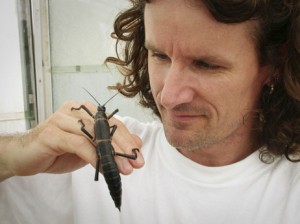
Nick Carlile, seen here with the Lord Howe Island stick insect, discovered the thought-to-be extinct phasmid in 2001 on Ball’s Pyramid.
When the team went back to collect them, it turned out there had been a rock slide on the mountain, and at first they feared that the whole population had been wiped out. But when they got back up to the site, on Valentine’s Day 2003, the animals were still there, sitting on and around their bush.
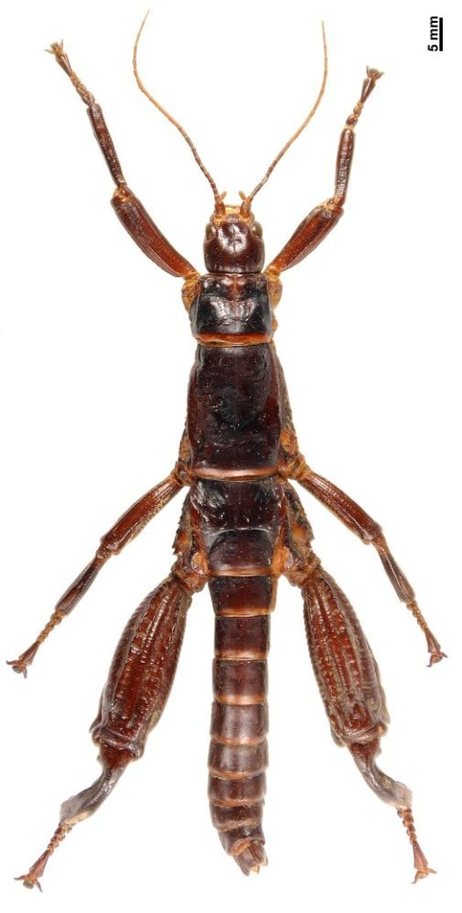 Male Lord Howe Island Stick Insect K.
Male Lord Howe Island Stick Insect K.
For more, see the Source.
Thanks to Skylaire Alfvegren and others for the news tip.
About Loren Coleman
Loren Coleman is one of the world’s leading cryptozoologists, some say “the” leading living cryptozoologist. Certainly, he is acknowledged as the current living American researcher and writer who has most popularized cryptozoology in the late 20th and early 21st centuries.
Starting his fieldwork and investigations in 1960, after traveling and trekking extensively in pursuit of cryptozoological mysteries, Coleman began writing to share his experiences in 1969. An honorary member of Ivan T. Sanderson’s Society for the Investigation of the Unexplained in the 1970s, Coleman has been bestowed with similar honorary memberships of the North Idaho College Cryptozoology Club in 1983, and in subsequent years, that of the British Columbia Scientific Cryptozoology Club, CryptoSafari International, and other international organizations. He was also a Life Member and Benefactor of the International Society of Cryptozoology (now-defunct).
Loren Coleman’s daily blog, as a member of the Cryptomundo Team, served as an ongoing avenue of communication for the ever-growing body of cryptozoo news from 2005 through 2013. He returned as an infrequent contributor beginning Halloween week of 2015.
Coleman is the founder in 2003, and current director of the International Cryptozoology Museum in Portland, Maine.
Filed under Breaking News, CryptoZoo News, New Species